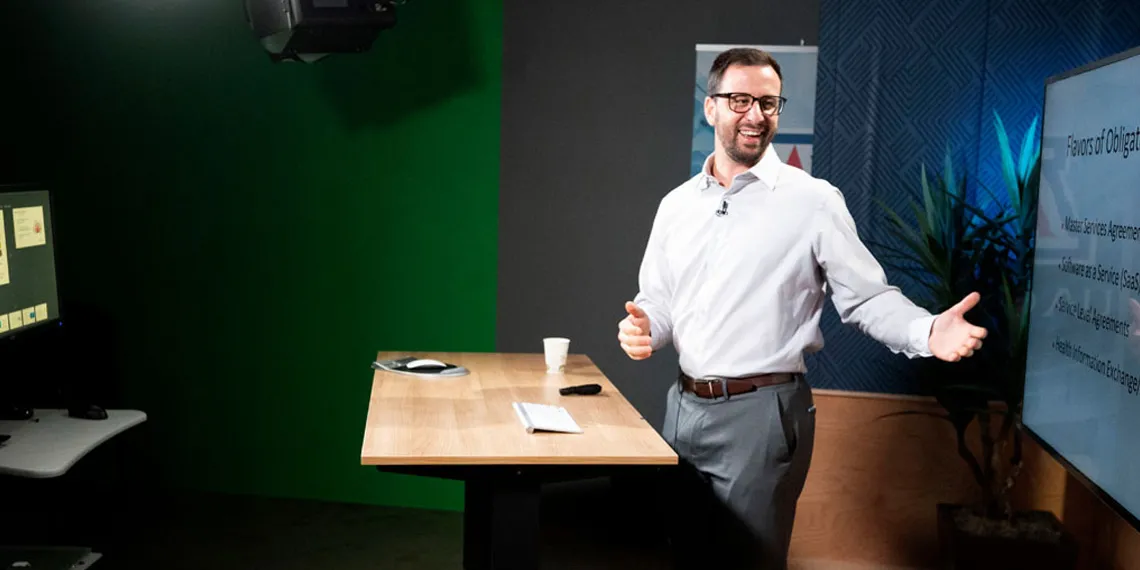September Showcase: A More Welcoming Welcome
Instructor Chase Millea, JD, takes a multi-faceted (and multimodal) approach to creating an inviting welcome to his course.

One of the most challenging barriers in online teaching is feeling connected. Students can feel isolated, approaching activities and assessments as tasks to complete rather than feeling engaged in learning. Student’s questions may remain unasked, since typing them into an email feels tedious, or they may think it’s a silly question and not want to “waste the professor’s time.” Instructors may try to design discussions that engage students, but in making instructions and expectations clear, the discussion becomes less conversational. Teaching asynchronously can sometimes feel robotic, clicking through rubrics and posting grades.
While teaching an online course, especially asynchronous, is challenging, there are strategies for making connections in online classrooms. I recently worked with Chase Millea, JD, an adjunct professor for Rogers College of Law, in developing a course, Health Information Technology.
Chase’s class includes interactive learning activities to help students engage with the content, discussions that include video and Adobe Spark posts to encourage multi-dimensional interaction, and he elected to create his own presence in the course in multiple ways.
The Instructor Bio Page
Chase created his instructor bio page in D2L, which includes a professional-style headshot, his contact information, office hours and meeting scheduling, and expected turnaround times for communication and grades. He also added professional details such as his education background and where he currently practices law. Some instructors add academic publications and/or research specializations on this page.
The Intro Video
We at Digital Learning recommend including a short introduction video to welcome students to the course. For Chase’s course, the introduction video gives students a tour of the course, covering the course objectives. He also chose to continue using very short intro videos to show students how to complete the Introductions discussion using Adobe Spark, how to locate images with Adobe Stock, and how to navigate custom learning activities we created for his course using H5P. Each of these videos includes screen captures to demonstrate navigation, and they were unscripted, providing a relaxed, casual style.
The Introductions Discussion
In face-to-face classes, opportunities for personal self-expression happen organically, such as clothing items, stickers on a laptop or water bottle, or bits of casual chat before class, but such opportunities need to be created intentionally in the asynchronous online environment. We created a discussion board in D2L and assigned an “Introduce Yourself” discussion. The prompt includes a list of questions ranging from professional (e.g. degree, ideal job) to fun (e.g. one item to have on a deserted island) to stimulate responses. Students use Adobe Spark to introduce themselves, answering questions or sharing details through the use of both text and images. Students shared requested information, but they also used creative expression to share things that are more difficult (or less common) to put into words. Chase created his own Spark post, which served as an example, but also provided an opportunity to be present in the course in a more personal way.
View Chase Millea's Spark Post
We hoped Adobe Spark would provide a way for students to better participate in an icebreaker discussion to introduce themselves since it is an easy tool to learn and use, even for those who have never worked with media production tools before. Several of the assignments and discussions offer the option to submit either a multimedia or written response, with the content requirements being the same for either type of submission. Chase has been happy to see that students are heavily utilizing Spark in their responses, and have even progressed to using more features, such as adding audio and video.
By intentionally creating multiple ways to be present in the course, Chase was able to adapt some of the subtleties of in-person communication to the asynchronous online environment, creating a fun, friendly, interactive student experience.
For more information on Adobe Spark and other Adobe Creative Cloud applications, visit Adobe & Arizona


